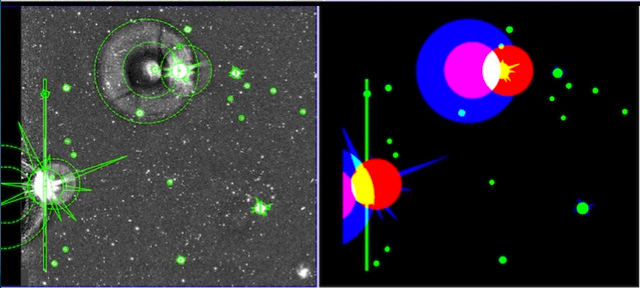Masking of bright stars and defects
A stand-alone program dubbed Pulecenella v1.0 (Huang et al. 2013, in prep.) was developed to create masks for KiDS-ESO-DR1 coadds. It is an automatized procedure for mask creation completely independent from external star catalogs. An example of a detail of a mask is shown in the figure below. Pulecenella detects the following types of critical areas, all related to bright stars:
- saturated pixels,
- spikes caused by diffraction by the mirror supports,
- readout spikes,
- reflection halos produced by the optics components (a central core halo, and up to three wider reflection halos with spatially dependent offsets, depending on the brightness of the star.
Defects that are not related to bright stars, such as satellite tracks (if missed by automated masking during de-trending) or other artifacts, are not detected by Pulecenella; for KiDS-ESO-DR1 coadds these areas have been masked by hand and included in the final masks.
The masks are provided as FITS FLAG images, where each type of critical region is identified by a different flag value, as listed in the table below. During source extraction for the single-band source list (see below) the FLAG image is used to flag sources whose isophotes overlap with the critical areas. The resulting flags are stored in the following two source parameters:
- IMAFLAGS_ISO: FLAG image flags OR'd over the isophote profile
- NIMAFLAG_ISO: number of flagged pixels entering IMAFLAGS_ISO
| Critical areas in the masks and their flag values | |||
|---|---|---|---|
| Type of area | Flag value | Type of area | Flag value |
| Readout spike | 1 | Secondary halo | 16 |
| Saturation core | 2 | Tertiary halo | 32 |
| Diffraction spike | 4 | Bad pixel | 64 |
| Primary halo | 8 | Manually masked region | 128 |

